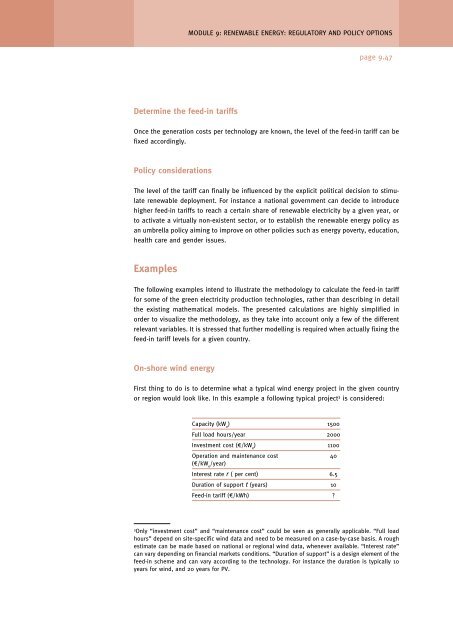Regulatory and policy options to encourage development of ...
Regulatory and policy options to encourage development of ...
Regulatory and policy options to encourage development of ...
- No tags were found...
You also want an ePaper? Increase the reach of your titles
YUMPU automatically turns print PDFs into web optimized ePapers that Google loves.
MODULE 9: RENEWABLE ENERGY: REGULATORY AND POLICY OPTIONSpage 9.47Determine the feed-in tariffsOnce the generation costs per technology are known, the level <strong>of</strong> the feed-in tariff can befixed accordingly.Policy considerationsThe level <strong>of</strong> the tariff can finally be influenced by the explicit political decision <strong>to</strong> stimulaterenewable deployment. For instance a national government can decide <strong>to</strong> introducehigher feed-in tariffs <strong>to</strong> reach a certain share <strong>of</strong> renewable electricity by a given year, or<strong>to</strong> activate a virtually non-existent sec<strong>to</strong>r, or <strong>to</strong> establish the renewable energy <strong>policy</strong> asan umbrella <strong>policy</strong> aiming <strong>to</strong> improve on other policies such as energy poverty, education,health care <strong>and</strong> gender issues.ExamplesThe following examples intend <strong>to</strong> illustrate the methodology <strong>to</strong> calculate the feed-in tarifffor some <strong>of</strong> the green electricity production technologies, rather than describing in detailthe existing mathematical models. The presented calculations are highly simplified inorder <strong>to</strong> visualize the methodology, as they take in<strong>to</strong> account only a few <strong>of</strong> the differentrelevant variables. It is stressed that further modelling is required when actually fixing thefeed-in tariff levels for a given country.On-shore wind energyFirst thing <strong>to</strong> do is <strong>to</strong> determine what a typical wind energy project in the given countryor region would look like. In this example a following typical project 3 is considered:Capacity (kW e) 1500Full load hours/year 2000Investment cost (€/kW e) 1100Operation <strong>and</strong> maintenance cost 40(€/kW e/year)Interest rate r ( per cent) 6.5Duration <strong>of</strong> support t (years) 10Feed-in tariff (€/kWh) ?3Only “investment cost” <strong>and</strong> “maintenance cost” could be seen as generally applicable. “Full loadhours” depend on site-specific wind data <strong>and</strong> need <strong>to</strong> be measured on a case-by-case basis. A roughestimate can be made based on national or regional wind data, whenever available. “Interest rate”can vary depending on financial markets conditions. “Duration <strong>of</strong> support” is a design element <strong>of</strong> thefeed-in scheme <strong>and</strong> can vary according <strong>to</strong> the technology. For instance the duration is typically 10years for wind, <strong>and</strong> 20 years for PV.










